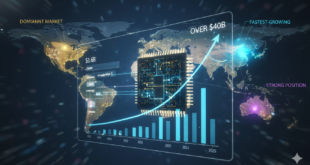Revolutionizing Biotechnology: DNA Printing & Gene Synthesis Unlock Infinite Possibilities
Discover how DNA printing and gene synthesis are redefining medicine, agriculture, and industry with unprecedented precision and accessibility.
Introduction
The field of biotechnology is undergoing a paradigm shift with the emergence of DNA printing and artificial gene synthesis technologies. These groundbreaking innovations are transforming our ability to design and construct genetic material, opening new frontiers in medicine, agriculture, and industrial applications. Unlike conventional genetic engineering approaches that modify existing DNA, these cutting-edge techniques enable scientists to build custom genetic sequences from the ground up.
The synthetic biology market, valued at 13.4 billions in 2022, 60 billion by 2030. This remarkable expansion is fueled by several key advancements including enzymatic DNA synthesis platforms, compact benchtop DNA printers, and revolutionary genome assembly techniques like CReATiNG that are making genetic engineering more accessible and cost-effective than ever before.
This remarkable expansion is fueled by several key advancements including enzymatic DNA synthesis platforms, compact benchtop DNA printers, and revolutionary genome assembly techniques like CReATiNG that are making genetic engineering more accessible and cost-effective than ever before.
These technologies enable scientists to manipulate the very building blocks of life, allowing for unprecedented control over genetic material. In this article, we will delve into the fascinating world of DNA printing and artificial gene synthesis, exploring their applications, challenges, and the ethical considerations that come with them.
Understanding DNA printing
DNA printing is the process of synthesizing DNA molecules using chemical or enzymatic methods. This technology is based on the same principles as inkjet printing, but instead of ink, DNA nucleotides are used to create a pattern on a substrate. Just like 3D printing creates physical objects layer by layer, DNA printing assembles genetic material base by base. This technology enables the creation of custom-designed DNA strands with precise sequences and functionalities. DNA printing can be used to create synthetic genes, gene arrays, and even entire genomes.
The Evolution of DNA Printing Technology
DNA printing has progressed dramatically since its origins in the 1980s with phosphoramidite chemistry. While revolutionary at the time, this early method posed significant environmental and safety challenges due to its reliance on toxic chemicals. The field has since transitioned to enzymatic DNA synthesis (EDS), representing a quantum leap forward in safety, precision, and accessibility.
Today, DNA printing is undergoing a transformation with the advent of enzymatic DNA synthesis (EDS). This newer technique uses biological enzymes, such as terminal deoxynucleotidyl transferase (TdT), to build DNA in water-based environments, offering greater speed, precision, and sustainability. Unlike traditional methods, EDS reduces reliance on toxic solvents and allows for the synthesis of longer DNA strands with fewer errors. Commercially available benchtop synthesizers based on EDS now empower even small labs to produce custom DNA sequences within hours, drastically reducing costs and turnaround time.
Modern EDS systems can now reliably produce DNA strands up to 1,000 nucleotides long with exceptional accuracy, enabling researchers to create complex genetic constructs that were previously unattainable. Commercialization efforts by companies like DNA Script and Molecular Assemblies have brought benchtop DNA printers to market, allowing laboratories to synthesize custom DNA sequences on-demand with turnaround times reduced from weeks to mere hours. This technological democratization is accelerating research across academic and industrial settings.
Transformative Applications Across Industries
The potential applications of DNA printing are staggering and touch nearly every sector of biotechnology and life sciences. In biomedical research, custom DNA sequences allow scientists to study genetic mutations, model diseases, and engineer targeted therapies. In vaccine development, especially for mRNA platforms like the COVID-19 vaccines, synthetic DNA is used to create antigen-coding sequences with remarkable speed and accuracy.
Revolutionizing Modern Medicine
The COVID-19 pandemic served as a powerful demonstration of synthetic biology’s potential, with mRNA vaccines developed in record time through artificial gene synthesis. This achievement represents just the beginning of medical applications:
Personalized cancer vaccines represent one of the most promising applications, where DNA printing creates customized immunotherapies tailored to individual patients’ tumor profiles. The field of gene therapy is experiencing unprecedented growth, with over 2,000 therapies in development that frequently rely on synthetic DNA to correct genetic defects. Public health infrastructure is being transformed by synthetic biology platforms capable of designing and producing vaccine candidates within days of identifying new pathogens.
Agricultural Transformation
Gene synthesis is addressing critical global food security challenges through climate-resilient crop engineering:
Drought-resistant wheat varieties now in development can maintain yields with 40% less water requirements. Nitrogen-fixing cereal crops are being engineered to reduce fertilizer needs by 50%, offering more sustainable agricultural practices. Scientists are combating the TR4 fungus threatening global banana supplies through disease-resistant strains created via synthetic biology approaches.
Industrial Biotechnology Advances
Meanwhile, synthetic biology is harnessing the technology to create entirely new biological systems for applications like biodegradable materials, industrial enzymes, and biofuels.
Sustainable material production includes companies like Bolt Threads creating eco-friendly textiles from engineered spider silk proteins. The green chemistry revolution has already seen engineered microbes take over 20% of global vitamin B2 production. Cutting-edge carbon capture solutions are being developed using synthetic algae strains designed for industrial-scale CO2 absorption.
There’s also growing interest in using DNA as a storage medium for digital data. Theoretical models suggest that a single gram of DNA could store up to 215 petabytes—equivalent to 50 million DVDs—with exceptional longevity. Though far from commercial readiness, such concepts could redefine data storage paradigms.
Artificial Gene Synthesis: A Specialized Discipline
Artificial gene synthesis, a focused branch of DNA printing, enables scientists to create genes from scratch or modify existing ones with incredible precision. Unlike traditional cloning methods, gene synthesis bypasses the need for a DNA template, assembling genes directly from nucleotides. It supports everything from the construction of novel genes to the fine-tuning of existing sequences for improved function.
Gene synthesis is used to engineer proteins, develop RNA-based therapeutics, and design next-gen diagnostic tools. Its applications span from creating synthetic microbial genomes to producing therapeutic antibodies and CRISPR components for gene editing.
One major breakthrough was the synthesis of the entire phiX174 bacteriophage genome in 2003, a pivotal moment that demonstrated the feasibility of assembling functional viral genomes entirely in vitro
Cutting-Edge Technological Innovations
Recent advancements are pushing the boundaries of what DNA printing and gene synthesis can achieve. Researchers at the University of California, Berkeley, have developed a benchtop DNA printer capable of synthesizing oligonucleotides up to 120 bases long, while a team at the University of Washington has extended this limit to 1,000 bases using enzymatic synthesis.
MIT scientists have introduced unnatural base pairs that make DNA more resistant to extreme environments like heat or radiation. These synthetic building blocks can help create organisms suited for industrial or extraterrestrial environments.
The CReATiNG Method Breakthrough
Developed by researchers at USC Dornsife College, the CReATiNG (Cloning Reprogramming and Assembling Tiled Natural Genomic DNA) technique represents a monumental advance in synthetic genomics:
This innovative approach reduces synthetic chromosome construction costs by up to 90% compared to traditional methods. It enables creation of hybrid yeast strains with enhanced capabilities for biofuel production. Early experiments have demonstrated the ability to alter yeast growth rates by 68% through strategic genetic rearrangements, revealing profound insights into genetic architecture.
Benchtop DNA Printing Revolution
The democratization of DNA synthesis is accelerating through compact, affordable systems:
DNA Script’s Syntax system represents a major advancement with its ability to produce 96 oligos in parallel within hours. Kilobaser’s innovative devices allow laboratories to print their own primers at unprecedented low costs of $0.05 per base. This technological accessibility is empowering smaller research teams and academic laboratories to participate in cutting-edge genetic engineering.
Expanding the Genetic Alphabet
Scientists are pushing boundaries by developing synthetic base pairs beyond nature’s ATCG:
Novel base pairs (X-Y) have been created that function alongside natural DNA in synthetic organisms. These artificial nucleotides enable more stable genetic constructs and novel protein designs. Potential applications include ultra-secure molecular data storage systems with exponentially greater density than conventional media.
Ethical Considerations and Regulatory Challenges
As capabilities expand, the field faces important ethical questions and practical challenges. Ethical concerns include the possibility of designing harmful pathogens or unauthorized human enhancement via gene editing. Cost and synthesis errors remain barriers, particularly for long or complex sequences. As synthesis becomes more accessible, the risk of misuse also increases.
Biosecurity concerns have emerged regarding potential misuse of DNA synthesis technology. In response, international collaborations like the International Gene Synthesis Consortium (IGSC) have implemented comprehensive sequence screening protocols. Environmental impact assessments are crucial for synthetic organisms, driving development of advanced containment strategies and biological “kill switches.”
Ensuring equitable global access to these transformative technologies remains an ongoing challenge being addressed through open-source initiatives and technology transfer programs.
The industry is proactively addressing these concerns through multiple approaches:
Automated DNA sequence screening systems now check all synthetic orders against comprehensive pathogen databases. Advanced biocontainment strategies include engineered dependency on synthetic nutrients not found in nature. Global partnerships are working to establish ethical guidelines and regulatory frameworks that promote responsible innovation while enabling scientific progress.
Future Directions and Emerging Possibilities
The coming decade promises even more dramatic advances in genetic engineering capabilities:
Whole genome synthesis projects are currently underway with goals to synthesize complete human chromosomes, building on previous successes with microbial genomes. Next-generation in vivo DNA printing systems aim to enable direct genetic rewriting within living cells and organisms. Pioneering research in quantum biology may unlock new methods to enhance DNA synthesis precision through quantum effects.
As these technologies mature, they will increasingly blur traditional boundaries between biological and digital systems, potentially enabling:
Living biocomputers that process and store information using DNA molecules. Biological manufacturing systems that grow everything from pharmaceuticals to construction materials. Personalized microbiome therapies featuring engineered organisms designed to support human health.
Conclusion
DNA printing and artificial gene synthesis represent far more than just new laboratory tools—they signify a fundamental transformation in our relationship with biological systems. From curing genetic diseases to developing sustainable solutions for climate change, these technologies offer unprecedented potential to address humanity’s greatest challenges.
However, this remarkable power brings profound responsibility. As we stand at the threshold of this new era in biotechnology, we must develop these capabilities thoughtfully and deliberately. The future of genetic engineering isn’t simply about what we can create—it’s about making wise, ethical decisions about what we should create. Through responsible innovation, global collaboration, and thoughtful regulation, we can harness these technologies to benefit all of humanity while minimizing potential risks
 International Defense Security & Technology Your trusted Source for News, Research and Analysis
International Defense Security & Technology Your trusted Source for News, Research and Analysis




